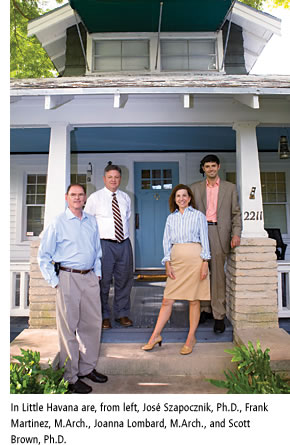 A new study produced by the Miller School’s Center for Family Studies and the University’s School of Architecture is deepening existing research on how “walkable” communities contribute to the health, safety, and well-being of the people who reside in them.
A new study produced by the Miller School’s Center for Family Studies and the University’s School of Architecture is deepening existing research on how “walkable” communities contribute to the health, safety, and well-being of the people who reside in them.
The group’s study reveals that the prevalence of architectural features like front porches, windows, and stoops positioned close to the sidewalk result in better physical functioning for Hispanic elders living in Miami’s East Little Havana neighborhood. The findings appeared in the October issue of the journal Environmental Health Perspectives.
Supported by grants from the Robert Wood Johnson Foundation, the National Institute of Mental Health, the National Institute of Environmental Health Sciences, and the National Institute on Aging, the researchers found that elders who resided on blocks with few positive front-entrance features were 2.7 times as likely to have subsequent poor physical functioning compared with elders who lived on blocks with a greater number of positive front-entrance qualities.
“In this study we’re looking at how to grow communities in which elders can remain and preserve their good physical functioning while living in the community,” says José Szapocznik, Ph.D., chair of the Department of Epidemiology and Public Health and director of the Center for Family Studies, who led the study at the center with research assistant professor Scott Brown, Ph.D., and Joanna Lombard, M.Arch., from the School of Architecture.
“If communities protect elders’ functioning, the elders will be able to stay in their homes for a much longer period of time.”
The group is now using the same data to determine where elders walk, which will help them determine what aspects of the built environment promote or discourage physical activity among elders. |


